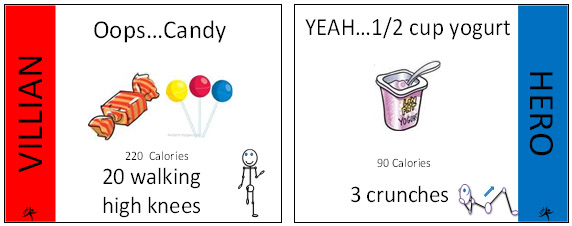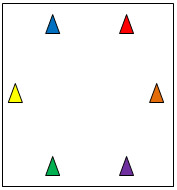Mad Meal Dash
Quick LinksInformation: Activity Description (PDF) Resources: Mad Meal Dash Recording Sheets (PDF) |
Activity Description and Rules:
The objective of the game is to create a meal (with the heroes) that represents three of the five food groups. To begin, groups are created with two to four students per group. The teacher tells the groups that they want their meal (breakfast) to be a certain number of calories (i.e. between 280-400 calories). For example, the teacher says all groups need to create a breakfast representing three of the five food groups that is close to 320 calories. The groups then try to collect heroes to be as close as possible to the teacher’s specified number.
Below are examples of the hero and villain cards. There are 20 hero and 20 villain cards. The villain cards have poor breakfast choices. The villain cards also have a higher number of repetitions for the activities. For example, a villain card may have 15 crunches where as a hero card may only have 3 crunches. The activity is associated with the calories. The higher the number of calories the more repetitions for the activity.

How to Play:
- A group rolls the die to see where they will go to get their first card. If they roll a 2 the group will go to the #2 station card. (See below for the playing space diagram.)
- A group will select a card. If the card was a villain, the group would complete the activity and place the card in their plastic bag. (The bag represents trash.)
- If the card has a hero, they will perform the activity listed on the card, keep the card and write down the number of calories on the student recording sheet.
- Groups can ONLY hold three heroes at a time.
- The groups are trying to get heroes from three different food groups that represent close to a set number of calories. (The teacher sets the calorie number between 280-400 calories.)
- When the time is called, (teacher will designate a time limit - 5 minutes or longer), the students will add the calories on their hero cards to see how close they are to the number of calories the teacher designated.
Debriefing questions to ask students following the game:
- Create a meal using three cards and representing three food groups for the villains. Compare the number of calories for that meal to the hero meal.
- Discuss the differences in good (hero) and poor (villain) food choices.
Equipment:
- Six cones. Tape station cards to cones.
- Playing cards (villains and heroes)
- Frisbee at each cone.
- One plastic bag, dry erase marker, die, and a student recording sheet per team
Playing Space and Set-Up:
 Arrange six cones into a large square, this will create
the playing area. The larger the square, the more
the students are moving. The cards (villains and heroes) are
split evenly between all six cones. Place the cards face down
in a Frisbee at each cone.
Arrange six cones into a large square, this will create
the playing area. The larger the square, the more
the students are moving. The cards (villains and heroes) are
split evenly between all six cones. Place the cards face down
in a Frisbee at each cone.
Game Modifications:
Version #1: If the group selects a villain, they must first complete the activity and then discard the card at the station.
Version #2: Have groups attempt to create two meals. One meal would be to collect three villain cards and the other meal would be to collect three hero cards. With the villain cards, the group would try to get the most calories for the three cards. With the hero cards, the group would try to get a meal between (250-400 calories).
Version #3: Have groups wear pedometers. The group that gets to a set number of steps first wins. (ex. 1000 or 2000 steps as a team). Average the number of steps if the groups are uneven.
Print Directions:
Print the station cards on white card stock and laminate. Print the playing card pages 2-11 first and then print playing card page 1 (Mad Meal Dash card) on the back. You will need to print 4 copies of the villain cards and 2 copies of the hero cards for a class of 25 students. You want to have more villain cards than hero cards to play the game.
**This activity was created in collaboration with the 2010-2011 JMU PHETE Graduate class (Allyce Burdette, Matthew Cottino, Shannon Dougherty, Nathalie Eakin, Danielle Hayek, Megan Kelly, Eric Monger, Alex Reece, Phillip Slade, Jared Sronce, Liz Walsh, Shelby Webb).